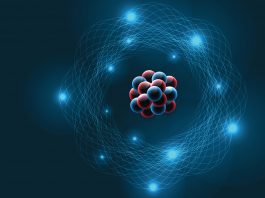Scientists examine the behaviour and trends of how positively and negatively charged ions interact within a solid and aqueous solution.
A collaboration of scientists from the Cluster of Excellence RESOLV at the Ruhr-University in Brochum, CALSOLV in Berkeley, and the University of Evry in Paris grouped together in order to investigate how positively and negatively charged ions behave at the interface between a solid surface and an aqueous solution.
At the SOLEIL synchrotron facility in France, they were able to use terahertz spectroscopy to examine exactly when and how the water shells around sodium for chloride ions to be stripped away when voltages are applied in an electrolyte solution.
The researchers illustrated their results in the journal Proceedings of the National Academy of Sciences of the United States of America, or PNAS, published online on 15 November 2021.
Electrochemical double layer between electrolyte and solid interface
Electrolytes are a chemical compound in which separate ions occur. For instance, when sodium chloride (NaCl) is dissolved in water, the positively charged sodium ions and the negatively charged chloride ions separate, being able to move freely within the solution. As a result of the electrical attraction between the ions and the water molecules, a shell of water molecules forms around the individual ions, that some label a so-called hydration shell, that is stable in the solution. A layer of charge carriers forms in the immediate vicinity of the electrical boundary layer between the electrode and water. A positive and a negatively charged layer are opposite each other, which is why this layer is also referred to as an electrochemical double layer. According to chemistry textbooks, the following happens when a voltage is applied: the attraction between the electrode and the ions strips off the water shell and a charge transfer, a current, occurs.
This simplistic picture illuminates how a battery works. In their present work, the researchers from Bochum, Berkeley and Paris investigated whether this is also correct at the molecular level. They also analysed whether the process is identical when negative or positive voltages are alternately applied.
Observation of positive and negatively charged ions during this process is challenging
Studying a chemical process on a molecular level while a voltage is applied is a special experimental challenge. However, this is what this group of scientists succeeded in doing in the current study with terahertz spectroscopy, which they combined with simulations. For this purpose, they investigated the electrochemical double layer that forms in a NaCl solution in the immediate vicinity of a gold surface at the SOLEIL synchrotron in Paris.
Terahertz spectroscopy allows it to be possible to examine the stripping of the hydration shell live. The researchers also showed for the first time how the water networks on the charged gold surface change. This is essential in order to understand how the total energy shifts during in the process. “It was astonishing for us to see that the process runs differently for positive and negative charges,” explained Professor Martina Havenith, spokesperson of RESOLV.
Results: asymmetric detachment of the hydration shell
The scientists discovered that the hydration shells of sodium and chloride ions behaved differently in the electrochemical double layer. The hydration shell of the positively charged ions was already detached at low voltages and the sodium ion became attracted to the electrode. For the negatively charged chloride ions, this only occurred at a higher applied voltage. The team were able to attribute these differences to the behaviour of the water networks at the interface. The scientists confirmed the results with the help of complex computer simulations.
“The method and the results can now be used to investigate the crucial role of water in other interfacial processes, for example at semiconductor/ electrolyte interfaces,” explained Martina Havenith. The results are important for understanding and optimising electrochemical processes. For example, within technological applications such as solar cell or fuel cell technologies.









